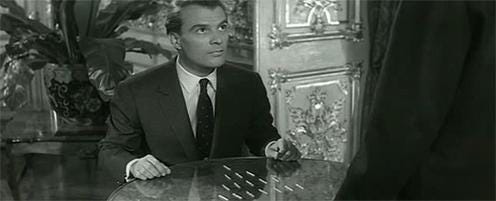2001: A Space Odyssey, Heidegger's Propriative Event, and the Technological Saving Power of Cinema.
Before addressing shadow movement, time’s originating as it passes, or causality for the casual set, can we spare a second to ask after technology’s provenance? Why presume to know the arrow of technological time’s direction? As apes in 2001: A SPACE ODYSSEY transition from frames of savagery, to effective use of tools, to interstellar travel by means of causea efficient technology, Heidegger asks “Of what essence is modern technology that it happens to think of bringing exact science to use?”1
Garry Leonard writes in Kubrick's Monolith and Heidegger's Propriative Event,
In the first shot of the sequence where the ape "discovers" the bone is a hammer, Kubrick shoots from a low angle to show the "edge" of the monolith bisecting the sun. It is not yet designed as a sundial, but it is already acting as one, dividing the sun into "moments," causing a shadow to move, and thereby establishing a cause and effect relationship between the motions of the planetary body and the "passing" of time. Conflating time with the movement of the shadow, time "passes" in the sense that it is understood as moving forward and cannot be seen as "moving backwards." There is nothing in the revolution of the earth itself to suggest "moving forward" or its ideological corollary, progress.
If as Heidegger says, technology “brings us closer to being” as “a way of revealing,” and “a way of bringing forth,”2 then does technology, from its roots as technē, once the poíēsis of the fine arts after all, precede, proceed, or preclude humanity’s culpability of being?
If in the Greenwich mean time of today we edge towards corruptive catatonia, dare we then demonize our singular rearward-looking attempt at “the revealing that brings forth truth into the splendor of radiant appearance”?3 Might technological ‘discovery’ be an extratemporal drive to object-orient the sorrow and despair of our revulsion against time? Might the technological train be started in 1968’s motion pictures of tomorrow in ORDET to deliver us from the imaginal inanition of today?
A concession: trusting technics beyond its comprehensible intelligence is the opposite risk position to Pascale’s wager, a wager which boils down to an unenticing, “What’s to lose but a good time?” There is much to be squandered amidst the transhumane annihilation-bias of The Gambler’s Ruin. Another Alexandrian library loss could occur with all the ease of mechanical motion needed to corrupt a teraflop of Virtual Real Porn defilations on the Seagate called Moment.
The risk is that given enough time and determinism, Machinic Desire can hallucinate the natural flow of the whole human-dreamt entire. Only consequent to immersing ourselves in a Metaversion of hell.exe might we realize that technology only iterates a for loop of the ever-same.
But if then weren’t we always in for?
If then, wouldn’t one reason to hand the keyframes of intelligence over to deep convolution be to reconceal that “the future is not later than having been.”4 If by then and again we have only technology to reboot our temporal logic operating systems, to let us begin again before the blurring begins, when what can no longer technē caul thee be called human consciousness begs not to be eternally elongated in the overlapping of the self with the computer-brain-interfaced other—if by then would we remember the propriative technological event not as intruder, not as the frames of the film, but as Leonard’s “progenitor and remainder”?
Could we then recaul that the monolith of technê logic truth is no more than a sundial to dissect the sun, to create time, to unconceal progressive temporality so that less tenable TENETS of temporality can remain unconcealed: Computer-Brain-Interfacial tenets hinted at by the term prisoner’s cinema meaning: closed-eye hallucinations caused by an absence of visual stimuli.
If time itself lies hallucinatory and inhospitable, will we wager in good faith backwards and vor wars? Will we implant and then implement the interface to feel a little Shafer distinguishing between uncertainty and ignorance, to reify what was hoped to be in Kahantian perception, intuition, and experience: Murkily, MARIENBAD. Nimly, the returning hours and rider. Dimly, AFTER SUNSET. Nominally, Omens of Millennium as trees in Bloom. Numinally, SUNRISE.
If we are mere event handlers whileing away in a control structure, then a Metaverse of Amazon Web Services may indeed be a danger of eternal protention and retention; or, a block chain may be a saving power of Eisentseinian montage offer and echo waving a retraceable path back into a metaphysical coordinate system. As we might relate from what Einstein says in our elementary school books, “Every reference-body (co-ordinate system) has its own particular time; unless we are told the reference-body to which the statement of time refers, there is no meaning in a statement of the time of an event.” Generally, we accept this. Yet still the images of the monolith appear and reappear at the same time code upon every recurrent embarkation upon The Odyssey.
Leonard waits on THE THIN RED LINE of disembodied reference for an uncaught Train,
The constant and ineradicable presence of the monolith, which never seems to be decoded or absorbed by these technological advances, will not allow either this myth of origin or the subsequent myth of progress to cohere. The monolith is always proximate to discovery and development, but it always precedes it, exceeds it, and is never surpassed by it. Buried, unburied, afloat in orbit, or in a dying man's bedroom, it persists as an ineradicable progenitor and remainder, the inscrutable presence of which defamiliarizes the myth of origin.
As new centrodes for the old penitentiary collapse into the accelerated frame of being, can we collide the possible and the post-possible, can we differentiate and repeat the Settingson the eternal re-emergence of the same?
A shot by shot analysis of the bone to hammer sequence makes it clear Kubrick visualizes it as an uncovering, leading to the emergence of an attitude—primarily exultant and triumphant- that is simultaneous with the emergence of a technological mode of consciousness relative to one's surroundings. Because the unexplained appearance of the monolith precedes this moment, Kubrick's depiction cannot be simply a representation of "the dawn of man." Instead it is the emergence of one mode of knowing among any number of possible modes
We’ve had fifty years to wait on what film, this hybrid of technology and time, can telos about what modes may come. “The monolith itself, were it to be laid on its side, would have the dimensions of a movie screen,” writes Leonard, “so the ‘enframing’ it permits us to witness is both existential and literally cinematic. Enframing is the condition of possibility that sets up an unconcealment, in this case, the ape positioning himself before the bones.”
Kubrick said the “third artifact placed in orbit around Jupiter” is “waiting for the time when man has reached the outer rim of his own solar system.” Seems one day we’re framed up fighting over the mud puddle, next we’re in some rococo technê palace, wondering if the same support settings that Terminated our Life Functions also brought us to the saving power’s door stop, Beyond the Infinite, where the ceiling is no longer uncannily illumined but the floor. A room where things like conscience and anguish are just inventions, what Kubrick calls, “A human zoo approximating a hospitable terrestrial environment drawn out of [Bowman’s] own dreams and imagination.”
Exploding our selves out through the filmic pod, cast a little older with each epochal shift in technological perspective, not necessarily wiser as to where our meat ends, or as to why any omnibenevolent entity worth its gestalt would gestate proteins in some INTERSTELLAR ANIMAL FACTORY, Kubrick describes Bowman’s arc: “In a timeless state, his life passes from middle age to senescence to death. He is reborn, an enhanced being, a star child, an angel, a superman, if you like, and returns to earth prepared for the next leap forward of man’s evolutionary destiny.”
Siegfried Krakauer illustrates how films such as DR. MABUSE, THE GAMBLER tried to warn Weimar Germany of the Third Reich’s emergence. Historically, we intuit that charges have hyperbolically evolved into a real future by the influence of or a dependence upon A World of Movies. Movies are dreams helping us process the past through NIGHT AND FOG, even if It’s All Forgotten Now as the credits reel. Movies predict the future through precognitive awakenings to societal somnambulance, predictions slept on in the fifteen years From Caligari to Hitler.
Enframed in an empty set of Disneyfied imagery, our particular prisoner’s cinema causing hallucinatory world events, the train having long left the station—recall that the tracks remain in place as our primordial connection to the image available in 1080p, Blu-Ray, and Betamax. To this end, a good film to show a child is BRIEF ENCOUNTER. A good Tony Perkins picture is GOODBYE AGAIN. A good song from THE SHINING soundtrack is It’s All Forgotten Now. Uncertain of technological truth claims up to and including the inherent irrationality of 1s that are also 0s, the best we might encourage is to attend these movies as a primary mode of care, to watch what awaits cinematic unconcealment, to watch what “still keeps to the trace of the holy,” in the long laneway proceeding and preceding the gateway called this regrettable moment. As Kubrick told Playboy Magazine, “However vast the darkness, we must supply our own light.”
Heidegger, The Question Concerning Technology
Ibid
Ibid






